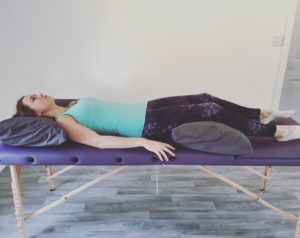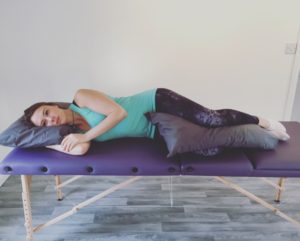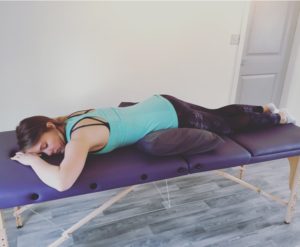I received this question last week… it’s one I’ve been asked many times over the years so wanted to share my top tips with you!..
“Hi Sammy,
I’m sick of getting woken up by back pain and feeling stiff as a board when I get up… What’s the best position for me to sleep in for my back?
Thanks, Margaret”
Great questions from Margaret! Some positions a more likely to trigger back pain, whilst others help ease it. So here I’ll share with you which is the best for you, no matter which position you typically sleep in.
But to do this it important to first understand, why we get back pain in bed in the first place…
Many believe it’s the way we sleep that causes back pain in bed… when it fact that’s just the warning sign to let you know there’s an issue (or potential issue) there. Typically it’s tight, weak muscles and stiffness joints that causes the pain. This weakness can happen to us for many reasons: lack of stretching and strengthening the right muscles*, poor posture, and ignoring back pain rather than doing something about it before it becomes a problem.
*(Top Tip: Activities like Pilates, Yoga, and walking are GREAT for your back – as well as many other joints)
So why does it become painful in bed?
In bed you’re resting, so you would think that this would ease back pain not worsen int. You see, when we sleep our muscles naturally get colder and tighten, simply because they are not being used. When we sleep the warm blood flow is sent away from our muscles and to our brain as we dream, and stomach to digest our dinner.
So this is why you’re more likely to feeling tight and stiff first thing on a morning as we wake and get ourselves up out of bed.
During the day our muscles and joints are under a lot a pressure, and if they’re not strong enough then what happens is when you go to sleep they’ll want to tighten up because they’ve been working too hard during the day. You may not necessarily feel any discomfort during the day because the muscles are being used and are warm and stretched… as well as our busy minds are probably focusing on something else. But this discomfort that keeps you tossing and turning in bed, and the stiffness you feel in the morning is our body’s way of telling us it needs a little help.
But back to the question in hand…
How do we help stop our backs tightening and aching when in bed?
Simple. The position we put our backs into while we sleep can play a big part.
If you sleep in a ‘twisted’ position, or if your lower backs curved whilst you sleep it’s literally squashing the joints together (and it won’t like it). So if we can tweak these positions to gentle stretch and take the pressure off then back then ‘hey-presto!’
We all naturally have different positions we like to to sleep in. Whether it be on our back, front, side…
…(or the one I’ve come to know as the “spiderman” – half on your front with your leg out to the side. If you do it you’ll know what I mean! lol).
So here are my best tips to make sure you’re protecting your back whist you sleep.
Which type of a sleeper are you? Front, back, or on your side?
Back Sleepers
Ok so to know surprise sleeping on your back generally is a great position for your back (as well as the rest of your body) but if you’ve got quite a natural curve or arch in your lower back then this can be quite uncomfortable.
How to beat it:
Using a pillow or two, place them under your knees and lower legs. This helps lift the legs and takes the pressure from your lower back whilst you sleep.

Side Sleepers
Firstly, lets answer the question “why does sleeping on your side hurt your lower back, and maybe into your hips?”
Our hips are typically one of the widest points of our body, so when you’re lying on your side the top leg lowers down the rest of the below one, and in turn twists your back and pelvis.
How to beat it:
This one you may have come across before but not been sure why it works… but sleeping with a pillow between your knees is a brilliant way to protect your back whilst you’re sleeping. The pillow will keep your legs parallel with you hips and keep any aching pressure away from your lower back.

Front Sleepers
So in general sleeping on your front isn’t the best for your backs but also your neck too. When on your front can “squash” your lower back causing it to feel tight and aching (as well as having a twist your neck).
If you can avoid sleeping on your front then I do recommend it. However if you’ve always slept on your front and its what feel most naturally for you then here’s what to do next.
How to beat it:

Using a pillow, place it underneath your hips and this will help stretch and ease any pressure on your lower back. Be careful put to place it too much under your stomach as you don’t want to squash last nights dinner!
Also, if you find standing causes your back to ache, then this can be a lovely resting position to help stretch it back out again.
…
So here’s my best tips to help ease your back pain whilst you sleep!
However, if your back pain persists or worsen then it always best to find out that’s causing it in the first place by speaking with a physiotherapist.
If you have any questions at all about you’re back pain I’m always happy to help!
Sammy 🙂
Physiotherapist
PS – Typo’s are free 🙂
